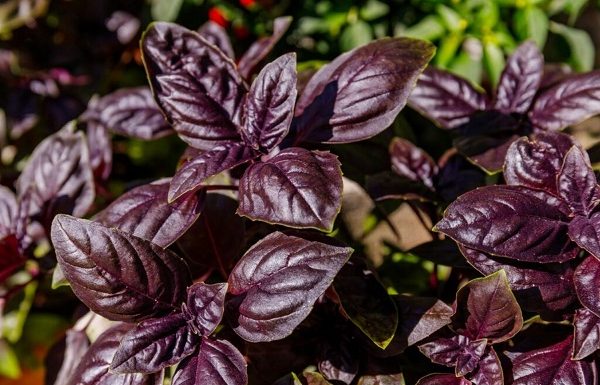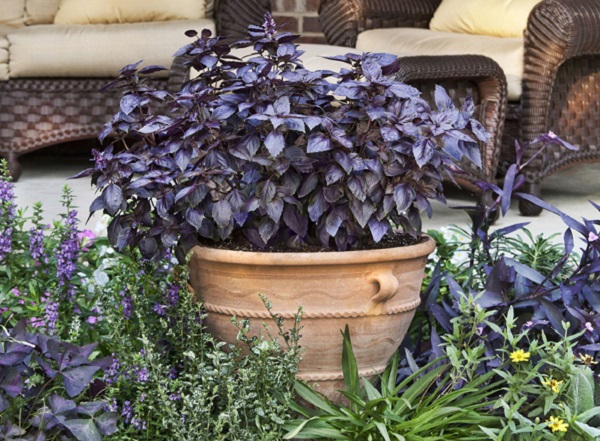
With the scientific name Ocimum basilicuma, holy basil or tulsi is a plant that has traditionally been used both as a culinary ingredient and as a medicinal plant. Currently, it is cultivated practically all over the world, although it is a species native to India.
If you want to learn how to care for purple basil at home to benefit from all its properties, join us in this article, in which we also tell you what it is for.
Climate and location for Purple basil

In the same way that it happens with the common basil, this plant needs to be protected from the wind and the cold, and is that although it supports cool temperatures somewhat better than its relative, the holy basil is undoubtedly a plant with a mild climate.
Its ideal temperature is between 15 and 25 ºC, being probable that from there, the leaves lose that characteristic pigmentation that gives the plant its first name and turns green. Due to the lower limit, it is always necessary to avoid exposing the plant to temperatures below 10 ºC for a long time, although it can withstand occasional drops to close to 0 ºC.
Find a location where it receives as much light as possible, even directly, for 6 to 8 hours a day. As long as these conditions of temperature, light and shelter from the wind are met, it is possible to grow purple basil both indoors and outdoors, although depending on the local climate, it will be more or less viable to do so in the orchard or garden.
Substrate and compost for holy basil
This plant is not particularly demanding in terms of its soil, the only really important thing being that it is in soil with the best possible drainage, with a certain capacity to retain moisture.
In this case, the universal seedling mix that we usually recommend will be just as valid. Prepare coconut fiber, worm humus and peat in equal parts, mix them well, and add a handful of vermiculite and perlite. This results in the soil being very rich in nutrients and beneficial microorganisms, light and with great drainage, which, thanks to vermiculite and perlite, will retain moisture much better for the roots.
Outdoors, find an area where irrigation water does not accumulate or, if you do not have good soil, empty space of half a meter and fill it with the mixture described above. A mulch will also help maintain better temperature and humidity levels for the plant.
Regarding the fertilizer, it will be enough to add some organic matter such as worm humus or compost in the warm months to the base of the plant every 15 days.
Watering the holy basil
Since it needs a substrate that remains humid (never confuse humid with waterlogged), holy basil needs very frequent waterings, although not too abundant. This is especially important if you have your plant in a pot, having to increase the frequency of watering even more so that the substrate never dries up completely unless you live in an area with a very humid or tropical climate.
Still, it is necessary to remember that a wet substrate is not a waterlogged substrate: excess water harms practically all plants even more than drought, and holy basil is no exception. If you puddle your soil or substrate, pests and diseases are likely to appear.
Pruning holy basil
As with all types of basil, pruning is very important for the plant, especially when looking to harvest it. Since the part that is usually consumed are the leaves, it is necessary to prevent the plant from consuming its energy producing flowers since this also changes the taste of the leaves and makes them bitter. When your holy basil begins to produce flowers, pinch them and remove them immediately. When you need a piece to use in the kitchen, sanitize a pair of scissors and cut as many leaves as you need, but avoid cutting the central stem.
What is holy basil for?
As a medicinal plant, holy basil is attributed a large number of properties and benefits, among which the following stand out:
- Powerful antioxidant.
- Helps against bronchial respiratory problems.
- Antibacterial
- Antifungal.
- It has relaxing and anti-stress properties.
- It is also anti-inflammatory.
- Protects the cardiovascular system.
Thus, taking into account its properties, it is common to use it regularly for all types of stress problems, skin, such as acne and insect bites, and as an antioxidant reinforcement and preventive effect against heart problems. It is also taken to reduce symptoms such as fever and is known support in the prevention of some diseases such as malaria or dengue.
It can be taken added to meals as an aromatic herb, although skin problems will require it to be applied topically, applying the crushed leaves with a mortar.
It is also possible to chew the leaves to receive the calming effect, or take an infusion of holy basil for bronchial problems or fever, although sometimes it is mixed with cardamom, milk and sugar to enhance the effect.

